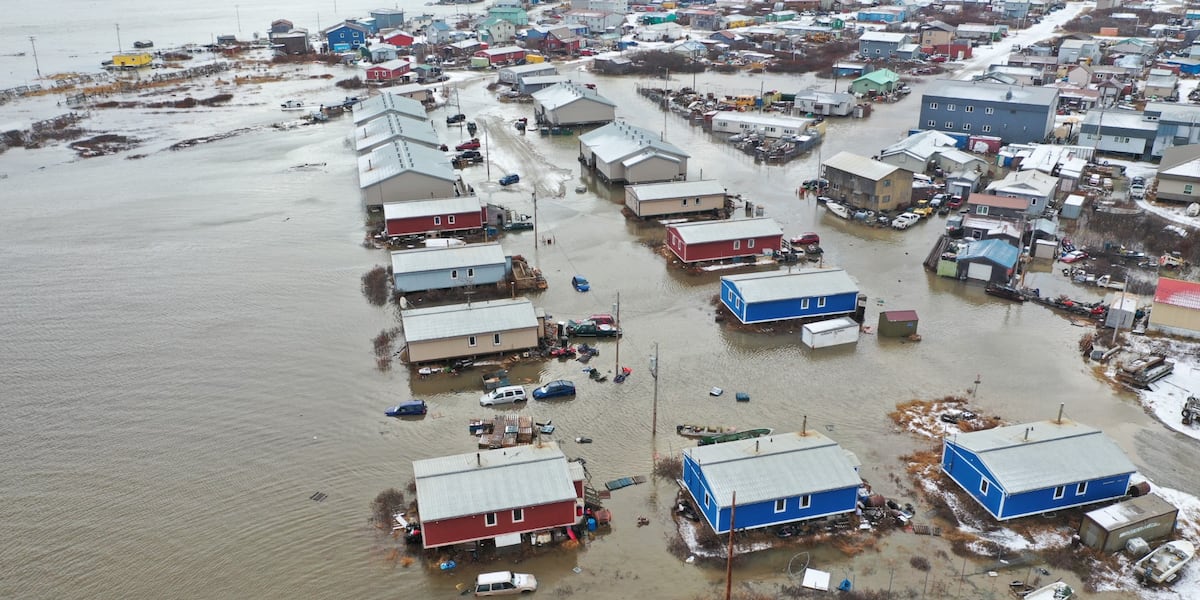Since a fiber outage left multiple Northwest Alaska and North Slope communities without internet and cell service last weekend, telecommunications service providers have been scrambling to restore connection — and some agencies, residents and businesses are adapting to pursue their own solutions.
On Sunday, heavy ice movement 34 miles offshore from Utqiagvik cut the subsea fiber network operated by broadband provider Quintillion. Fixing the fiber cut might take between six and eight weeks, depending on when the ice breaks up and how challenging the repairs will be, Quintillion President Mac McHale said.
Since the breakage, Utqiagvik, Wainwright, Point Hope, Kotzebue, Nome and Atqasuk have experienced service interruptions, which varied widely among the telecommunication providers using Quintillion’s fiber system, McHale said.
Many city government services were down in Utqiagvik and Kotzebue. Several residents in affected communities couldn’t use their phones to communicate with friends and family, and some businesses struggled to conduct financial transactions without having an internet connection.
To address the challenges, some were going back to analog operations — like businesses pivoting to cash transactions or libraries manually checking out books. Others turned to satellite internet alternatives to get back online, and some residents were unplugging all together.
“This outage affects everyone, personally and professionally,” Utqiagvik resident Mary Samuelu said.
Implications of outages
Outages continued to disrupt operations for some communities and businesses across the region Thursday.
In Utqiagvik, all city services, as well as the recently reopened DMV office, were down this week, according to the city’s online statements.
The City of Kotzebue also reported that there was no internet in all departments, including City Hall, the police department, fire department, parks and recreation, public works and Arctic Spirits.
“We’re fortunate that our emergency services still have been running,” Kotzebue City Manager Tessa Baldwin said. But “it’s really hard to run a government without internet.”
The widespread outage prevented the city from being able to connect to the server that helps the city operate, Baldwin said.
“Even if we got internet throughout the city, it won’t help if we don’t get into a server,” Baldwin said, “which is how we collect payments from the public, how we do payroll, how we basically function, and that also allows us to connect to the public through email.”
:quality(70)/cloudfront-us-east-1.images.arcpublishing.com/adn/NEPTXIXZT5GQZIUAGGYQ6OJSWI.jpg)
Some stores in Utqiagvik, Kotzebue and Nome were only taking cash, residents said.
“We usually don’t carry cash as much but have to keep some on us now because some stores are cash only until further notice,” Utqiagvik resident LeLe Poe said.
Libraries across the affected area were operating without internet, according to a statement from the Alaska Library Association.
“We just went analog,” said Janet Steppe, library assistant at the Kegoayah Kozga Public Library in Nome. “We couldn’t provide any internet services but we could just check out books manually.”
[From May: First lady Jill Biden and Interior Secretary Deb Haaland promote broadband investment in a historic visit to Bethel]
Darius Samuelu works with the North Slope Borough Police Department, and this weekend he was in Point Hope on a work trip, said his wife, Mary Samuelu. When the cell connection went out, Mary Samuelu said, she couldn’t reach him for over 36 hours.
“Being an officer’s wife, it was scary. All the crazy scenarios start running through your mind,” Mary Samuelu said from Utqiagvik. “From talking to your spouse every hour to not being able to talk to him was difficult.”
Eventually, Darius Samuelu used one of the nurse’s phones from the clinic to call her. “It was a big relief,” Mary Samuelu said.
Getting back online
This week, improvements were on the way for Northwest Alaska residents.
In North Slope communities experiencing outages — Utqiagvik, Point Hope, Atqasuk and Wainwright — Arctic Slope Telephone Association Cooperative was working on using the satellite network they had prior to switching to fiber, said Rebecca Sparks, ASTAC external relations manager. The company planned to first restore backup 911 services and then focus on getting cellular service back online, Sparks said.
“We are looking to restore services before the fiber cut is actually restored,” she said.
OTZ Telecommunications, which serves Kotzebue, was also planning to use satellite networks to partially restore internet service in the next few days, and continue the restoration process next week, OTZ Telecommunications CEO Kelly Williams said Thursday.
The North Slope Borough on Thursday declared a disaster emergency because of the communications disruption and planned to deploy “alternate satellite-based communications support” to multiple communities within a week to support key infrastructure and government operations, according to a report from the Alaska Division of Homeland Security and Emergency Management.
Some residents and local organizations, including the University of Alaska Fairbanks Chukchi Campus in Kotzebue and Iḷisaġvik College in Utqiagvik, were directly purchasing satellite services to stay online.
Microcom — a local retailer of satellite products, including Starlink internet — saw an immediate increase in demand from customers in Utqiagvik, Atqasuk, Nome and Wainwright, said the company’s communications director, Alexander Schumann. The company also reported more local equipment pickups in Anchorage from businesses, banks, tribal entities, nonprofits and corporations associated with the Arctic and Northwest regions of Alaska, he said.
“Today is probably the busiest day we’ve had,” Schumann said Tuesday. “We’ve probably shipped over 400 Starlink units today to people all over Alaska.” In comparison, on a typical day the company would ship a few dozen units, he said.
Until internet and cell service is restored, many residents are adapting to life without it.
In Point Hope, the service interruptions occurred at the time of Qagruq, the three-day whaling feast, slightly complicating feast preparations, Shingo Takazawa said. Whaling crews set up a windbreaker on the north side of the ceremonial site to protect the celebration from the elements, but the wind shifted to the south.
“They put a windbreaker on the wrong side,” Takazawa said. “But nobody has phone service, nobody knows the weather.”
Takazawa said there was also a positive side to losing service, On the third day of the feast, the residents sat and ate by the windbreaker, sharing stories and joking about using CB or VHF radios again.
“Nobody checking their cellphone, nobody talking on the phone, nobody’s phone ringing. So peaceful,” Takazawa said. “ Looks like we are going back to the old style. We are sharing old hunting stories, family history, experiences.”

:quality(70)/cloudfront-us-east-1.images.arcpublishing.com/adn/BNAF4CSP75C2HN3MMMUFZC5LVE.jpg)
:quality(70)/cloudfront-us-east-1.images.arcpublishing.com/adn/3SVTVAVG6ZCATN5VPP3PN5OCZM.JPG)




















/cdn.vox-cdn.com/uploads/chorus_asset/file/25822586/STK169_ZUCKERBERG_MAGA_STKS491_CVIRGINIA_A.jpg)

/cdn.vox-cdn.com/uploads/chorus_asset/file/25821992/videoframe_720397.png)




/cdn.vox-cdn.com/uploads/chorus_asset/file/23935558/acastro_STK103__01.jpg)